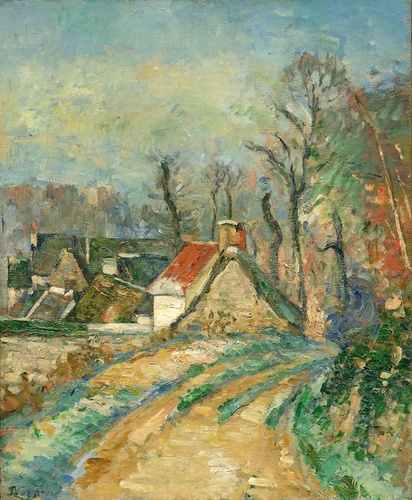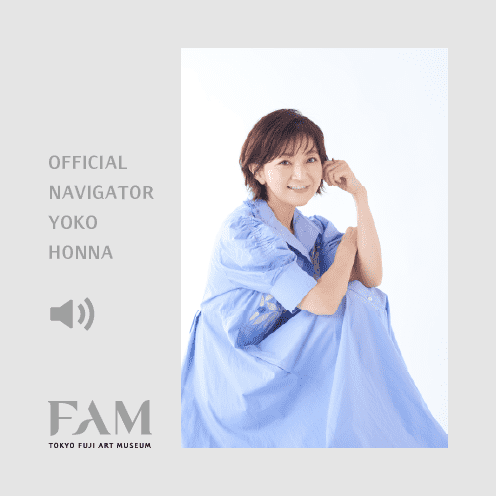c. 1873/Oil on canvas
59.7 x 49.0 cm
SUMMARY
Since 1866, Cézanne had been rejected by the Salon for four consecutive years. In 1869, the year he turned 30, he met a young model Marie-Hortense Fiquet, who would later become his wife, in Paris. In 1872, the couple had their first son Paul, and in the summer of that year, Cézanne traveled along with his family to Pontoise, where Pissarro had just moved into. He spontaneously began to execute paintings there together with Pissarro. In Auvers-sur-Oise, where Cézanne had been staying for a while, Pissarro introduced Cézanne to his physician Dr. Gachet, who was also an enthusiastic collector of avant-garde paintings, in the fall of the same year. On this occasion, Dr. Gachet recommended Cézanne to move into Auvers-sur-Oise with his family. Placing their easels side by side, Cézanne and Pissarro devoted themselves to painting together, developing a new style known as “Pontoise school,” which is characterized by the loves for pastoral themes, impasto paints and detailed painting. Under the influence of Pissarro, Cézanne abandoned his previous interest in literary themes and began to focus seriously on the visible external world of nature around him. In 1873, Cézanne eventually moved to Auvers-sur-Oise, where he spent most of that year and devoted himself to landscape paintings. The three paintings The House of the Hanged Man, A Modern Olympia and Landscape, Auvers that he created during this period were exhibited at the first Impressionist exhibition in 1874, but all ended up with negative reviews. For Cézanne, however, these paintings represented his starting point as a truly important painter. As the monumental works of his early career, The House of the Hanged Man and A Modern Olympia now decorate the walls of the Musée d'Orsay. (As for the other work, Landscape, Auvers, as there is no firm evidence to identify its picture, it is speculated that the work is the one now belonging to either the Philadelphia Museum of Art or the National Gallery of Art, Washington, D.C.). The period from 1872 to 1874 when Cézanne stayed in Pontoise and Auvers was an embryonic stage for him as a painter, and it is no doubt that his meeting with the artistic mentor and patron became a decisive factor in his future developments. It should be the most precious experiences for Cézanne that he was able to engage in the execution of paintings together with his mentor Pissarro, while learning his mentor’s skilled painting techniques and sense of humility towards the nature before them. According to Dr. Gachet, Cézanne went out to sketch twice a day: “Once every morning and once every afternoon, on cloudy days and sunny days alike, he would attack the canvas as if his life depended on it. As the months and seasons passed, the spring paintings of 1873 changed to winter scenes in 1874.” Although the Detour in Auvers was not exhibited at the first Impressionist exhibition, it was one of the works Cézanne created during his first period of staying in Auvers. This work has many common elements with the other works: the curving road, the modest dwellings, the height of the viewpoint, etc. Here, Cézanne used the vertically long canvas to emphasize the path and sky. Moreover, this shows a sign of “diagonal” and “constructive” touches of brush that would later become a characteristic of his paintings. In the collection of the Musée d’Orsay there are two other works resembling this work that were produced at the same location during the same period: The Village Road, Auvers, and The House of Dr. Gachet in Auvers. In terms of their technique and their perspective, which extracts the landscape, these works employ the same approach as the Detour in Auvers and indicate how thoroughly Cézanne was practicing landscape painting at the time. As for this work, it is said that along with their friend and the painter Mary Cassatt, prominent American collectors Mr. and Mrs. Havemeyer, who were credited with first bringing Impressionist paintings to the U.S., discovered this work at the Galerie Vollard in Paris and purchased it in 1901. In a way, this work is of historic significance as the first of Cézanne’s paintings to reach the U.S.
ARTIST
Paul Cézanne
1839-1906
List of artworks by the same artist
INFORMATION

Saturday, April 12 - Sunday, June 8, 2025
400 Years of Western Paintings – Masterpieces from Tokyo Fuji Art Museum – Nagoya City Art Museum (Aichi, Japan)
Friday, July 26 - Monday, September 23, 2024
400 Years of Western Paintings – Masterpieces from Tokyo Fuji Art Museum – Shizuoka City Museum of Art (Shizuoka, Japan)
Saturday, January 27 - Sunday, April 7, 2024
Frontiers of Impressionism: Paintings from the Worcester Art Museum Tokyo Metropolitan Art Museum (Tokyo, Japan)
Friday, July 28 - Sunday, August 27, 2023
Masterpieces of Modern Eastern and Western Painting Exhibition Ishikawa Prefectural Museum of Art (Ishikawa, Japan)
Saturday, September 17 - Sunday, November 20, 2022
400 Years of Western Paintings – Masterpieces from Tokyo Fuji Art Museum – Toyama Prefectural Museum of Art and Design (Toyama, Japan)
Saturday, July 16 - Sunday, September 4, 2022
Masterpieces from Tokyo Fuji Art Museum Kumamoto Prefectural Museum of Art (Kumamoto, Japan)
Saturday, March 19 - Sunday, May 8, 2022
Masterpieces of European Paintings From Tokyo Fuji Art Museum Collection Saga Prefectural Art Museum (Saga, Japan)
Saturday, October 23 - Sunday, December 26, 2021
The 400 Years of Western Painting: Masterpieces From Tokyo Fuji Art Museum Tochigi Prefectural Museum of Fine Arts (Tochigi, Japan)
Friday, July 9 - Sunday, August 29, 2021
400 Years of European Paintings: Masterpieces From Tokyo Fuji Art Museum Okayama Prefectural Museum of Art (Okayama, Japan)
Tuesday, December 15 - Sunday, January 31, 2021
How to Read Western Paintings: Masterpieces from Tokyo Fuji Art Museum Okinawa Prefectural Museum and Art Museum (Okinawa, Japan)
Saturday, September 12 - Tuesday, November 3, 2020
400 Years of Western Paintings: Masterpieces from Tokyo Fuji Art Museum Miyazaki Prefectural Art Museum (Miyazaki, Japan)
Wednesday, July 22 - Sunday, September 6, 2020
400 Years of Western Paintings: Masterpieces from Tokyo Fuji Art Museum Oita Prefectural Art Museum (Oita, Japan)
Thursday, February 20 - Sunday, April 12, 2020
How to Read Western Paintings: Masterpieces from Tokyo Fuji Art Museum The Museum of Modern Art, Ibaraki (Ibaraki, Japan)
Saturday, November 2 - Sunday, December 22, 2019
“Rendez-vous” through Arts―East Meets West― Kuboso Memorial Museum of Arts, Izumi (Osaka, Japan)
Tuesday, September 3 - Tuesday, October 22, 2019
Masterpieces of European Paintings From Tokyo Fuji Art Museum Collection Yamaguchi Prefectural Art Museum (Yamaguchi, Japan)
Saturday, January 12 - Saturday, May 4, 2019
500 Years of Western Paintings: Collection of Tokyo Fuji Art Museum Shanghai PowerLong Museum (Shanghai, China)
Tuesday, October 23 - Sunday, December 23, 2018
500 Years of Western Paintings: Collection of Tokyo Fuji Art Museum Tsinghua University Art Museum (Beijing, China)
Friday, June 16 - Sunday, November 19, 2017
Cézanne Fondation Pierre Gianadda (Martigny, Switzerland)
Saturday, April 4 - Sunday, September 27, 2015
Cézanne: Pioneer of Modern Art Pola Museum of Art (Kanagawa, Japan)
Wednesday, March 28 - Monday, June 11, 2012
Cézanne.Paris-Provence The National Art Center, Tokyo (Tokyo, Japan)
Saturday, February 7 - Sunday, April 12, 2009
Homage to Cezanne Hokkaido Museum of Modern Art (Hokkaido, Japan)
Saturday, November 15 - Sunday, January 25, 2009
Homage to Cézanne: His Influence on the Development of Twentieth Century Painting Yokohama Museum of Art (Kanagawa, Japan)
Saturday, July 14 - Sunday, November 25, 2007
Impressionists and Its Sources: Monet, Renoir, and Barbizon Masters Musee d'art Mercian KARUIZAWA (Nagano, Japan)
Saturday, October 28 - Monday, April 9, 2007
Turner e gli Impressionisti, La grande storia del paesaggio moderno in Europa The City Museum of Santa Giulia in Brescia (Brescia, Italy)
Friday, August 1 - Sunday, August 31, 2003
A Great Masters of Impressionist and Modern Arts Iwate Prefectural Hall (Iwate, Japan)
Friday, April 18 - Sunday, May 25, 2003
The Great Masters of Art Fukuoka Art Museum (Fukuoka, Japan)
Thursday, January 2 - Sunday, January 26, 2003
Great Masters of Modern Japanese Oil Paintings Saga Prefectural Art Museum (Saga, Japan)
Friday, November 8 - Sunday, November 24, 2002
Great Masters of Modern Paintings Nagasaki Prefectural Museum (Nagasaki, Japan)
Saturday, October 5 - Monday, November 4, 2002
Art of the West & Art of Japan Exhibition: Monet, Renoir, Cezanne… Ikeno Taiga, Tani Buncho, and Others Shimane Art Museum (Shimane, Japan)
Saturday, September 7 - Sunday, September 29, 2002
Four Centuries of Occidental Paintings from the Tokyo Fuji Art Museum Collection SOGO Museum of Art (Kanagawa, Japan)
Saturday, July 20 - Sunday, September 1, 2002
The Great Masters of Art Hida Takayama Museum of Art (Gifu, Japan)
Friday, June 7 - Sunday, June 23, 2002
Modern Western Oils and Engravings from the Tokyo Fuji Art Museum Collection Fukui City Art Museum (Fukui, Japan)
Saturday, May 11 - Sunday, June 2, 2002
Modern Western Painting Kagoshima Prefectural Museum of Culture Reimeikan (Kagoshima, Japan)
Saturday, April 13 - Monday, May 6, 2002
Modern Western Oils and Engravings from the Tokyo Fuji Art Museum Collection The Urasoe Art Museum (Okinawa, Japan)
Sunday, October 1 - Sunday, December 3, 2000
Masterpieces of Western Paintings from the Renaissance to the 20th Century National Dr. Sun Yat-sen Memorial Hall (Taipei, Taiwan)
Saturday, September 11 - Sunday, December 19, 1999
Cézanne and Japan Yokohama Museum of Art (Kanagawa, Japan)
Tuesday, October 14 - Sunday, November 30, 1997
Masterpieces of Western Oil Painting from the TFAM Collection Hong Kong Museum of Art (Hong Kong, China)
Saturday, June 24 - Sunday, September 3, 1995
French Impressionism: Symphony of Light and Color Santillana Foundation (Santillana, Spain)
Tuesday, September 20 - Sunday, November 27, 1994
Paris in 1874: The Year of Impressionism The National Museum of Western Art (Tokyo, Japan)
Friday, October 16 - Thursday, November 5, 1992
Masterpieces of European Oil Painting: The Paintings in 20th Century from the Renaissance to Impressionism China Art Gallery (Beijing, China)
Saturday, November 3 - Sunday, December 2, 1990
Masterpieces of European Oil Painting Ho-Am Art Museum (Yongin-gun, Kyunggi-do, South Korea)
Saturday, September 22 - Sunday, October 21, 1990
Masterpieces of European Oil Painting Ho-Am Gallery (Seoul, South Korea)
Provenance: H.O. Havemeyer, New York (possibly purchased from Vollard in 1901)
Literature : The H.O. Havemeyer Collection : Catalogue of Paintings, Prints, Sculpture and Objects of Art, 1931, p.328 (As Landscape) Lionello Venturi, Cézanne: Son Art – Son Œuvre, Paris, 1936, vol.1, p.348 (listed) cf. John Rewald, The History of Impressionism, New York 1973, p.299 Frances Weitzenhoffer, The Havmeyers Impressionism Comes to America, New York, 1986, pl.106, illustrated in color
EXPLORE

You can search and browse content on a platform across museums and archival institutions nationwide, and create My Gallery (online exhibition).

The Official Navigator of the Tokyo Fuji Art Museum is voice-over artist, actress and vocalist Yoko Honna. She narrates the Japanese-language presentation and audio guidance segments of the works of Western paintings on display at our New Wing Permanent Gallery.

